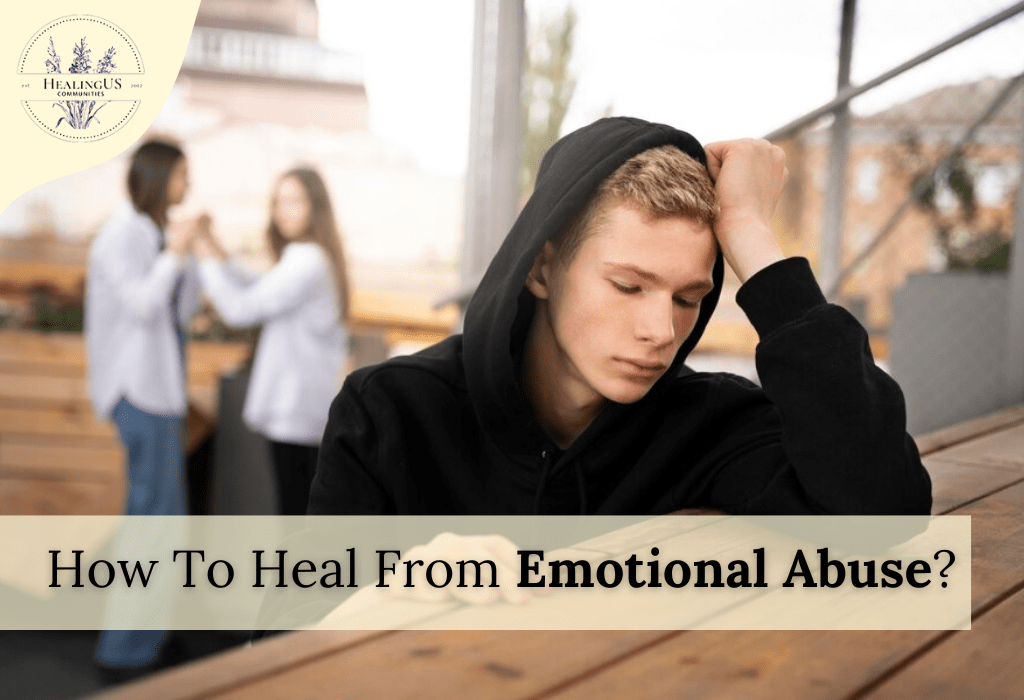Emotional abuse is a type of manipulation that leaves emotional wounds, not physical ones. It’s often hard to notice because it can be subtle. Emotional abuse can include things like insults, controlling behavior, isolation, or manipulation, and it can happen in any relationship—romantic, family, or even at work. The effects can lower your self-esteem, cause anxiety, and make you lose a sense of who you are.
Recognizing the signs of emotional abuse is essential for healing. If ignored, it can harm your mental and emotional health for a long time. This article will show you how to heal from emotional abuse, with steps to help you regain your self-worth and well-being.
How to Heal from Emotional Abuse?
Healing from emotional abuse involves recognizing the abuse, grieving your losses, setting firm boundaries, and seeking professional help or support groups to rebuild your well-being.
1. Acknowledge the Abuse
The first step in healing from emotional abuse is admitting that it happened. Emotional abuse can be hard to notice, and you might downplay its impact. You may think it wasn’t “that bad” or believe you caused it.
Recognizing it as abuse is important to validate your feelings. Labeling it as abuse helps you stop blaming yourself and start understanding. The longer you deny or minimize it, the longer healing will take. It’s okay to admit you were hurt and that you deserve to heal.
2. Allow Yourself to Grieve
Emotional abuse leaves deep emotional scars, often leading to feelings of loss. You might grieve the loss of your self-esteem, trust, security, or even the relationship. Grieving is a normal part of healing. Many people go through stages of grief, like denial, anger, bargaining, depression, and finally, acceptance.
Each stage helps you understand your emotions and what you’ve been through. There is no specific timeline for grief, so be kind and patient with yourself as you heal from emotional abuse.
3. Set Boundaries
Setting boundaries is crucial to protect yourself from more emotional harm. Boundaries act like a shield against others’ manipulation. During your healing, learning to speak up for yourself and set limits can make you feel stronger.
This might mean reducing contact with the person who hurt you or cutting them off entirely. It also means deciding what behaviors you won’t accept any more and sticking to those choices. Boundaries aren’t just about avoiding harmful people—they’re about taking care of yourself.
4. Seek Professional Help
Therapy is often needed to heal from emotional abuse. Types like Cognitive Behavioral Therapy (CBT) or trauma-focused therapy can be very helpful. A therapist can guide you in processing what happened, rebuilding your self-worth, and finding healthy ways to cope.
Along with therapy, support groups can also help. Sharing your experiences with others who have gone through similar things can make you feel less alone and give you comfort as you heal.
Tips to Overcome Emotional Abuse
1. Practice Self-Care
Healing from emotional abuse starts with self-care. Taking care of your physical, emotional, and mental health is key to recovery. Here are some simple steps:
- Engage in joyful activities: Find things that make you happy, like exercise, mindfulness, or hobbies.
- Focus on physical health: Make sure you’re getting enough sleep, eating well, and staying active.
- Practice self-compassion: Be kind to yourself during this healing process. Understand that it takes time, and it’s okay to have setbacks along the way.
Remember, healing is a journey. Practice self-compassion as you move through this experience.
2. Rebuild Your Self-Esteem
Emotional abuse can damage your self-worth and make you doubt your value. A key part of how to heal from emotional abuse is to rebuild your confidence. Here’s how to start:
- Acknowledge your strengths: Recognize your achievements, no matter how small they may seem.
- Practice positive self-talk: Encourage yourself with kind words and affirmations.
- Surround yourself with supportive people: Spend time with those who validate your feelings and uplift you.
Remember, rebuilding self-esteem takes time. Having a strong support network can make this process easier and faster.
3. Reframe Negative Thoughts
Abuse can lead to negative beliefs about yourself, such as “I’m not good enough” or “I don’t deserve better.” These thoughts can harm your mental health even after the abuse ends. Here’s how to challenge and change these beliefs:
- Cognitive reframing: This technique helps you question and replace negative thoughts with positive ones.
- Journaling: Write down your thoughts to identify harmful beliefs and reflect on them.
- Practice positive affirmations: Repeat encouraging statements about yourself to build a better self-image.
- Work with a therapist: A therapist can guide you in recognizing and changing these negative beliefs.
By actively working on your mindset, you can regain control over how you see yourself and develop a healthier, kinder view.
4. Rediscover Your Identity
Emotional abuse can cause you to lose your sense of self. When you’re constantly manipulated or controlled, it’s easy to lose sight of who you are. Here’s how to heal from emotional abuse by rediscovering your identity as part of healing:
- Reconnect with activities you love: Think about hobbies or passions you used to enjoy and start doing them again.
- Explore new interests: Try out new activities or experiences that excite you.
- Set personal goals: Focus on goals that reflect your values and what you want for your future.
Rediscovering your identity is important for your healing. It helps you regain a sense of self and empowers you to create the life you want.
The Long-Term Effects of Emotional Abuse
Emotional abuse can lead to long-term mental health problems, trust issues, and negative behaviors. Healing needs support, better communication, and breaking the cycle of abuse.
-
Mental Health Impacts
Emotional abuse can lead to lasting mental health issues like anxiety, depression, and PTSD. It can also cause chronic self-doubt, fear of intimacy, and feelings of unworthiness. To manage these effects, ongoing mental health support is crucial. Therapy, mindfulness, and a strong support system can help ease the emotional impact and provide tools for healing.
-
Effects on Relationships
Emotional abuse can make it hard to trust others and have healthy relationships. After being emotionally manipulated, you might fear being vulnerable or have trouble trusting in future relationships. It’s important to learn how to communicate well, spot warning signs, and build respectful, healthy relationships to break the cycle of abuse.
-
Breaking the Cycle of Abuse
Emotional abuse often follows patterns we learn from others. If you’ve been in an abusive environment, you might repeat those behaviors without realizing it. To break the cycle, it’s important to recognize these harmful actions and work to change them. By learning and teaching healthy ways to communicate, you can help prevent future generations from continuing abusive behavior.
FAQs
Q: How can you heal after emotional abuse?
A: Begin by acknowledging the abuse, then change negative thought patterns. Engage in self-care, set clear boundaries, and seek help when needed. It’s important to develop coping strategies and practice self-compassion throughout the healing journey.
Q: What type of therapy is most effective for emotional abuse recovery?
A: Cognitive Behavioral Therapy (CBT) helps address negative thinking patterns, while Dialectical Behavior Therapy (DBT) builds mindfulness and emotional regulation, both of which are highly effective in emotional abuse recovery.
Q: How can you release the impact of emotional abuse?
A: To release emotional abuse, identify triggers, process your emotions, and practice self-compassion. Seek support, develop coping skills, and engage in regular self-care to manage your emotional responses and begin to heal.
Conclusion
Healing from emotional abuse takes time, strength, and support. Recognizing the abuse, setting boundaries, rebuilding confidence, and getting help are key steps in regaining your well-being.
Recovery is not a race; everyone has their own timeline for healing. Don’t be afraid to seek therapy or lean on others for support. With patience and self-care, you can overcome emotional trauma and rebuild a healthier life.
Take the first step toward the way of healing. Join the HealingUS community today and connect with others who understand your path. Together, we can support one another in reclaiming our well-being.



